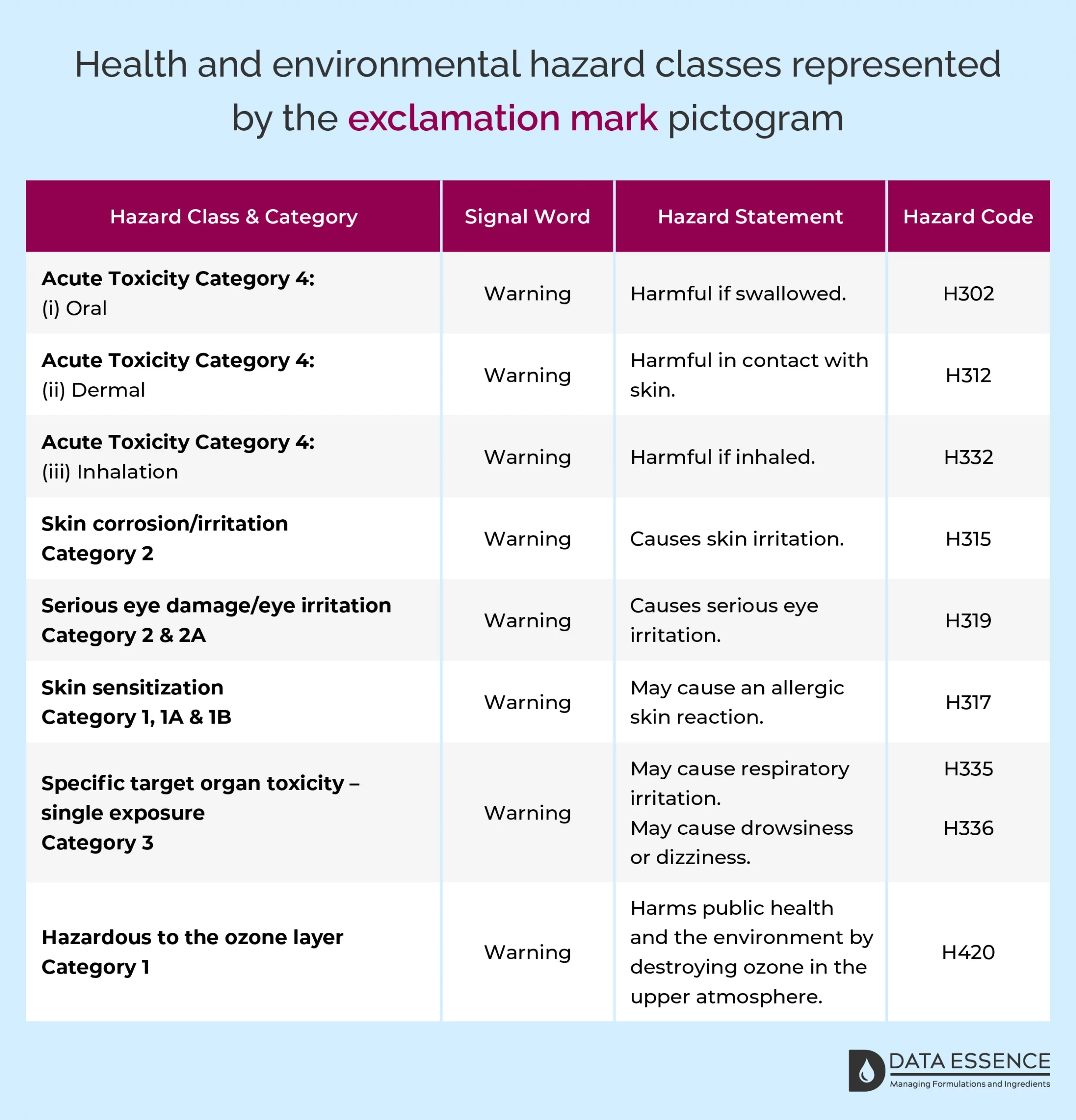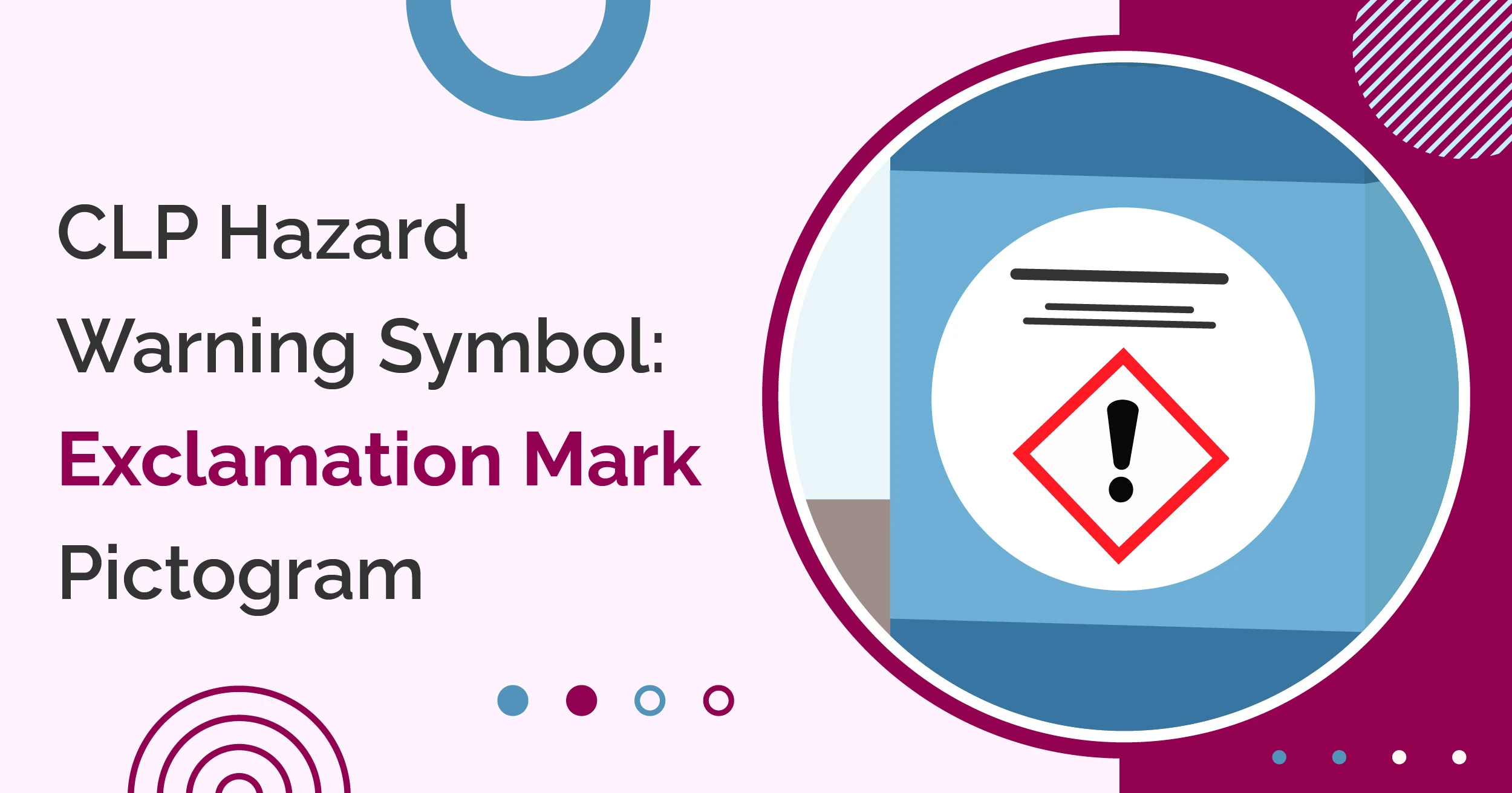Whether you already handle products with the exclamation mark or are simply interested in learning more about the necessary safety precautions, this blog post will provide you with valuable insights to protect yourself and others from potential hazards.
What does the exclamation mark pictogram mean?

What are health and ozone layer hazards?
The hazards associated with products featuring the exclamation mark pictogram include:
- Acute toxicity (Category 4): These products can be harmful if swallowed, inhaled, or if they come into contact with the skin.
- Skin corrosion/irritation (Category 2): These products can cause reversible damage like redness or inflammation when they touch the skin.
- Serious eye damage/eye irritation (Categories 2 and 2A): This category includes products that can irritate the eyes, causing reversible effects within 21 days of exposure or products that are severe skin irritants.
- Skin sensitizer (Categories 1, 1A, and 1B): These products can lead to allergic skin responses, causing symptoms such as itching, swelling, blisters, or redness. Some individuals may not show symptoms after the first exposure, but subsequent exposures trigger skin reactions. Common sensitizers include latex (found in gloves) and nickel.
- Specific target organ toxicity – single exposure (Category 3): These products can cause irritating effects on the respiratory tract, such as coughing or throat irritation, with a single exposure.
Apart from the hazards indicated by the exclamation mark pictogram, it is crucial to recognise that a product might present additional risks. These could include other health hazards like respiratory sensitization, germ cell mutagenicity, carcinogenicity, and specific target organ toxicity (repeated exposure). In addition to physical hazards such as flammability, reactivity, or corrosion of metals.
Health and Environmental hazard classes represented by the exclamation mark pictogram
We will look at each of these hazard classes in turn in relation to signal words, hazard statements and hazard codes.

The implications of the exclamation mark pictogram
Health risks
Substances marked with the exclamation mark symbol have the potential to inflict a range of negative health effects. It is essential to be aware of these risks when handling such substances:
- Respiratory irritation: Exposure to these substances may lead to respiratory irritation, causing discomfort and potential breathing difficulties.
- Drowsiness and dizziness: Some of these substances can induce drowsiness or dizziness, impairing your ability to function safely.
- Skin reactions: They can also trigger allergic skin reactions and skin irritation upon contact, leading to discomfort and potential skin damage.
- Eye irritation: Serious eye irritation is another concern, as these substances can harm the eyes upon contact.
- Harm if swallowed: Swallowing or ingesting these substances can be harmful to your health.
Environmental impact
Beyond the immediate health risks, substances marked with the exclamation mark symbol can also contribute to environmental degradation. Specifically, they have the potential to harm the ozone layer in the upper atmosphere. This poses a broader threat to public health and the environment as ozone depletion can result in increased ultraviolet (UV) radiation reaching the Earth’s surface, leading to various ecological and health consequences.
Protective measures for products marked with the exclamation mark pictogram
- Ventilation: Always ensure adequate ventilation when using these substances. Avoid inhaling dust, fumes, gas, mists, vapours, or sprays.
- Outdoor or well-ventilated areas: Whenever possible, use these substances outdoors or in well-ventilated areas to minimise exposure.
- Inhalation: If someone inhales these substances accidentally, promptly move them to an area with fresh air and allow them to rest in a comfortable breathing position.
- Ingestion: In case of ingestion, seek immediate medical advice by calling a poison centre or consulting a doctor/physician if you or someone else feels unwell.
- Protective gear: Always wear protective gear, including gloves, appropriate clothing, and eye and face protection, when handling these substances.
- Skin contact: If these substances come into contact with the skin accidentally, wash the affected area thoroughly with plenty of soap and water.
- Eye contact: If they get into the eyes, rinse cautiously with water for several minutes. Remove contact lenses if they are present and easily removable and continue rinsing.
- Avoid consumption: Never eat, drink, or smoke while working with substances displaying the exclamation mark symbol.
Safe storage of products marked with the exclamation mark pictogram
- Maintain safe storage: Regularly inspect containers and storage areas for any signs of leakage or damage.
- Containers: Keep the product in its original, labelled container.
- Ventilation: Store it in a well-ventilated area and ensure the container is tightly closed.
- Storage: Store the product in a cool, dry place away from direct sunlight.
- Avoid incompatible materials: Keep it separated from incompatible materials. Consult the Safety Data Sheet (SDS) for specific information about incompatible materials and conditions to avoid.
Conclusion
By acknowledging the potential multiple risks associated with substances that are hazardous to health or the ozone layer, understanding the implications is vital for personal safety and environmental protection. By implementing appropriate safety measures, we create a safer working environment for employees and minimise the possibility of accidents. Storing, transporting, and handling these products in accordance with the exclamation mark pictogram guidelines is essential to protect not only employees but also customers and the environment.

